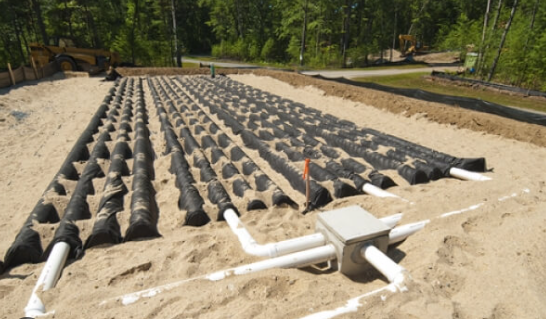You’ve just moved into your dream home in the countryside, complete with a septic system for wastewater treatment. While it’s an excellent way to manage your household’s sewage, there’s one critical aspect you need to understand: the max distance from septic tank to leach field.
This distance is not arbitrary; it’s a vital factor in ensuring your septic system operates efficiently, effectively treats wastewater, and doesn’t pose environmental or health risks.
The maximum distance from a septic tank to a leach field is not fixed and can vary depending on factors such as soil type, local regulations, and septic tank size.
However, a common industry guideline is to maintain a minimum distance of at least 10 feet between the septic tank and the leach field.
This minimum separation is crucial to allow for the settling of solids in the septic tank and the initial treatment of wastewater before it enters the leach field.
Local regulations and soil conditions may require a greater distance to ensure the effective treatment of wastewater and prevent contamination of groundwater or surface water sources.
It is essential to consult with local authorities and engage professionals for site-specific assessments and design to determine the appropriate separation distance for your septic system.
Components of a Septic System
Before delving into the intricacies of the maximum distance between your septic tank and leach field, let’s start with the basics of septic systems.
Components of a Septic System include:
- Septic Tank: This is the primary wastewater treatment component. It separates solids from liquids and initiates the decomposition process.
- Distribution Box: After initial treatment in the septic tank, liquid effluent flows into a distribution box, which evenly distributes it to the leach field.
- Leach Field: Also known as a drain field or absorption field, this is where the final treatment and disposal of effluent take place. It relies on natural processes and soil to purify wastewater.

Function and Purpose
The septic system’s primary function is to manage and treat wastewater generated in your home. It provides an environmentally friendly and efficient way to process sewage and return clean water to the ground.
Understanding how each component works is essential for ensuring the longevity and effectiveness of your system.
What Is a Leach Field?
Now that you’re familiar with the septic system components let’s focus on the leach field, which plays a pivotal role in the treatment of wastewater. A leach field is a designated area where treated effluent is released into the soil.
Its purpose is to allow the effluent to percolate through the soil, where it undergoes further purification through natural processes. The ultimate goal is to ensure that the effluent is safe to enter the groundwater without posing a threat to public health or the environment.
How Leach Fields Work
Leach fields work through a combination of physical, chemical, and biological processes:
- Physical Filtration: As effluent spreads through the soil, particles and impurities are physically filtered out.
- Chemical Reactions: Microbes in the soil break down harmful chemicals and pathogens in the effluent.
- Biological Decomposition: The soil acts as a biological filter, decomposing organic matter and converting it into harmless substances.
Key Factors Influencing Leach Field Performance
Several factors impact how well a leach field performs its wastewater treatment role. These factors include soil type, soil permeability, groundwater levels, and maintenance practices.
However, one of the most critical factors is the distance between the septic tank and the leach field.
The Role of Distance in Septic System Design
The distance between your septic tank and leach field is not arbitrary; it is carefully calculated to ensure the efficient and safe treatment of wastewater. Here’s why this distance is so crucial.
Importance of Distance Between the Septic Tank and Leach Field
The proper distance between the septic tank and leach field is essential for several reasons:
- Treatment Efficiency: The distance allows for the settling of solids in the septic tank and the initial treatment of wastewater, ensuring that only partially treated effluent reaches the leach field.
- Preventing Overload: Adequate distance prevents the leach field from becoming overloaded with effluent, which could lead to clogging, soil compaction, and system failure.
- Minimizing Contamination Risks: It reduces the risk of contamination of groundwater, surface water, and nearby wells with potentially harmful pathogens or pollutants.
Factors Affecting the Maximum Distance
The maximum distance between the septic tank and leach field is not a one-size-fits-all measurement; it varies based on several factors:
1. Soil Type and Permeability
Different soil types have varying degrees of permeability. Sandy soils, for example, allow water to pass through quickly, while clayey soils are less permeable.
The type of soil on your property directly affects how fast effluent can percolate, which, in turn, influences the required distance.
2. Local Regulations and Guidelines
Local health departments and environmental agencies often set specific guidelines and regulations governing septic system design, including separation distances.
These regulations are designed to protect public health and the environment. It’s crucial to familiarize yourself with your local requirements.
3. Septic Tank Size and Capacity
The size and capacity of your septic tank also impact the distance between the tank and leach field. A larger tank can hold more effluent, which might necessitate a longer distance to allow for proper settling and treatment.

Impact of Improper Distances
Failing to adhere to the recommended maximum distance between your septic tank and leach field can have severe consequences. Here are some potential issues that can arise from improper separation:
- Inadequate Treatment: Effluent may not receive adequate treatment before entering the leach field, leading to reduced treatment efficiency and potential contamination.
- System Failure: Overloading the leach field with effluent can cause clogging, soil compaction, and system failure, requiring costly repairs or replacements.
- Environmental Risks: Contaminants from untreated or poorly treated effluent can enter the groundwater, surface water, or nearby wells, posing health and environmental risks.
Maximum Distance Guidelines
So, what are the general industry guidelines for the maximum distance between your septic tank and leach field?
General Industry Guidelines
While specific recommendations may vary by region and soil type, a common industry guideline is to maintain a distance of at least 10 feet between the septic tank and the leach field. However, this is a minimum requirement, and many factors can necessitate a greater distance.
Specific Requirements in Different Regions or States
It’s essential to recognize that maximum distance requirements can vary significantly from one region to another.
Local health departments and environmental agencies establish specific requirements based on local conditions and regulations. Therefore, it’s crucial to consult with your local authorities to understand the precise separation distance applicable to your area.
Variations Based on Soil Conditions and System Types
Soil conditions play a significant role in determining the required separation distance. In areas with sandy soil that allows for faster percolation, the distance might be shorter.
In contrast, areas with clayey or less permeable soil may require a more extensive separation.
Moreover, the type of septic system you have can also influence distance requirements. Advanced systems, such as aerobic treatment units, may have different distance criteria due to their enhanced treatment capabilities.
Calculating the Optimal Distance
Now that you understand the factors affecting the maximum distance, how can you determine the right separation for your septic system? It’s a crucial decision that requires careful consideration.
Factors to Consider When Determining the Right Distance
1. Soil Percolation Tests
Conduct soil percolation tests on your property to assess the soil’s permeability. These tests measure how quickly water can pass through the soil, helping you determine the appropriate separation distance.
2. Local Regulations and Zoning
Research local regulations and zoning codes to understand the specific requirements for septic system design in your area. These regulations often include guidelines for separation distances.
3. Household Water Usage
Consider your household’s water usage patterns. Larger households with higher water consumption may generate more wastewater, necessitating a larger septic tank and possibly a greater separation distance.

Engaging Professionals for Site Assessment and Design
Given the complexity of septic system design and the importance of proper separation distances, it’s highly advisable to engage professionals for a site assessment and design.
Experienced septic system designers and engineers can evaluate your property’s unique characteristics and local requirements to determine the optimal separation distance and design a system that meets your needs.
Leach Field Sizing and Distribution
Once you’ve calculated the optimal distance, it’s essential to consider leach field sizing and distribution to ensure efficient treatment of wastewater.
Proper Sizing Considerations for Leach Fields
The size of your leach field should be proportional to the wastewater flow from your household. An undersized leach field can lead to overloading and system failure, while an oversized one may not receive enough effluent for proper treatment.
Professionals can help you determine the right size based on factors such as household size and water usage.
Strategies for Distributing Effluent Within the Leach Field
Effluent distribution within the leach field is critical for uniform treatment. This can be achieved through various distribution methods, including trenches, chambers, or pressure distribution systems. The choice depends on your property’s characteristics and design requirements.
Avoiding Common Design Pitfalls
Improper leach field design can lead to problems like ponding, odors, and uneven effluent distribution. Working with professionals ensures that your leach field is correctly designed to avoid these common pitfalls.
Maintaining Your Leach Field
Proper maintenance of your leach field is essential for long-term system performance and durability.
Importance of Regular Maintenance and Inspection
Regular maintenance and inspection are crucial for identifying and addressing issues before they escalate. Key maintenance tasks include:
- Pumping: Regularly pump the septic tank to remove solids and prevent buildup.
- Inspection: Inspect the septic tank, distribution box, and leach field for signs of damage or malfunction.
- Monitoring Effluent Levels: Keep an eye on effluent levels in the distribution box to ensure proper distribution to the leach field.
Signs of Leach Field Problems and How to Address Them
Be vigilant for signs of leach field problems, such as foul odors, slow drainage, or wet spots in the yard. If you notice any of these signs, it’s essential to address them promptly. Ignoring problems can lead to more significant issues and costly repairs.

Preventative Measures to Extend the Life of Your Leach Field
Taking preventative measures can help extend the life of your leach field:
- Water Conservation: Be mindful of water usage to prevent overloading the septic system.
- Proper Waste Disposal: Avoid flushing or disposing of non-biodegradable items or harsh chemicals that can harm the system.
- Vegetation Management: Ensure that trees and large shrubs are planted a safe distance away from the leach field to prevent root intrusion.
Alternative Septic System Technologies
While traditional septic systems are common, alternative technologies offer enhanced treatment capabilities and may have different distance requirements.
Alternative systems, such as aerobic treatment units (ATUs), mound systems, and constructed wetlands, use advanced treatment processes to further purify wastewater. These systems can be suitable for challenging soil or site conditions.
Impact of Technology Choice on Distance Requirements
The choice of septic system technology can influence the separation distance between the septic tank and the treatment component. Some advanced systems may have specific distance requirements based on their design and treatment capabilities.
Benefits and Drawbacks of Alternative Systems
Consider the benefits and drawbacks of alternative septic system technologies when making your choice. While they may offer superior treatment, they can also be more complex and costly to install and maintain.
Conclusion
Understanding the maximum distance between your septic tank and leach field is essential for the proper function and longevity of your septic system.
It’s not a one-size-fits-all measurement but rather a calculation based on factors like soil type, local regulations, and septic tank size.
Proper design, sizing, and maintenance are key to ensuring that your septic system operates efficiently, protects the environment, and poses no health risks to your family or community.
In summary, adhere to local regulations and guidelines, engage professionals for design and assessment, and prioritize regular maintenance to enjoy a trouble-free septic system.
By doing so, you’re not only safeguarding your property’s wastewater treatment but also contributing to the conservation of clean water and the protection of the environment.







